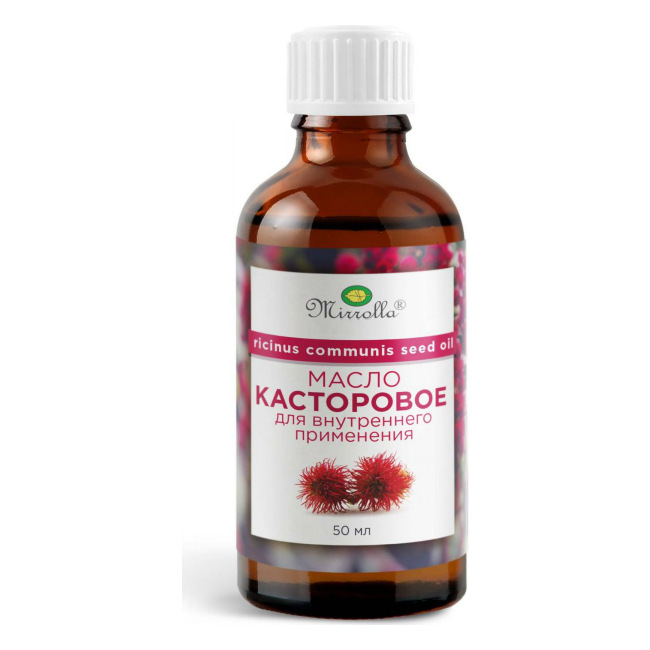Castor oil 50ml for food - Mirrolla
Castor oil is a plant-derived mild laxative.
After ingestion in the alkaline environment of the duodenum in the presence of bile, ricinoleic acid is formed from the oil under the influence of lipase.
The absorption of ricinoleic acid is inversely proportional to the size of the dose taken. With an administration of 4 g of oil, the absorption of ricinoleic acid is about 100%, with an administration of 50 g, only 36% is absorbed (the remaining acid is excreted with feces within 24 hours), and with an administration of 60 g, only 10% of the absorbed acid is present.
Composition
Castor oil (carrier), vitamin E (alpha-tocopheryl acetate).
Pharmacological action
Castor oil is a plant-derived mild laxative.
After ingestion in the alkaline environment of the duodenum in the presence of bile, ricinoleic acid is formed from the oil under the influence of lipase.
The absorption of ricinoleic acid is inversely proportional to the size of the dose taken. With an administration of 4 g of oil, the absorption of ricinoleic acid is about 100%, with an administration of 50 g, only 36% is absorbed (the remaining acid is excreted with feces within 24 hours), and with an administration of 60 g, only 10% of the absorbed acid is present.
The absorption rate of ricinoleic acid is half the rate of oleic acid absorption. To achieve a laxative effect, a minimum of 10 g of oil is necessary.
The absorbed portion of ricinoleic acid undergoes β-oxidation in the liver and skeletal muscles and is incorporated into metabolic processes.
Recommendations for use
As a laxative, adults are prescribed 15–30 g once a day. For bowel cleansing before diagnostic procedures, it is taken 2–6 hours before the examination. Children aged 12–14 are prescribed 5–15 g once a day.
In cases of weak labor contractions to stimulate labor activity, castor oil is prescribed at a single dose of 40–50 g against the background of using agents that stimulate uterine contractility.
In dermatological practice, for softening the skin and removing scales from areas of excessive keratosis, it is prescribed locally as a lotion on ethyl alcohol in a ratio of 1:10 with the addition of 2% salicylic acid (10 g castor oil, 2 g salicylic acid, ethyl alcohol up to 100 ml). The lotion is rubbed into the affected area once a day for 4–7 days, after which mechanical cleaning of the affected area is carried out, and treatment is continued.
For the treatment of burns and skin wounds, it is prescribed locally as lotions and emulsions on distilled water 1–2 times a day under a bandage.
To enhance hair growth, a solution is prepared consisting of 10 g of castor oil and 100 ml of 96% ethyl alcohol, which is rubbed into the scalp.
Side effects
- Abdominal pain, nausea;
- Digestive disorders, enterocolitis with repeated use;
- Vitamin deficiency A and D with repeated use;
- Blood flow to the pelvic organs;
- Dependency with repeated use.
Interaction
When used simultaneously, it reduces the absorption of fat-soluble vitamins A, D, and K. In doses up to 4 g/day, it increases the absorption of fat-soluble drugs - male fern extract, mebendazole, griseofulvin, probucol.
When used simultaneously with saline laxatives, a sharp increase in the laxative effect is possible.
M-cholinoblocking agents (atropine sulfate, platyphylline, pyrenzepine), spasmolytics (papaverine, drotaverine) weaken the action of castor oil.
Anticholinesterase agents (neostigmine, pyridostigmine, rivastigmine) and glycerin enhance the laxative action of castor oil.
It enhances the action of agents that stimulate uterine contractility (methylergometrine, ergometrine, oxytocin, prostaglandins) up to the threat of uterine rupture during childbirth.
When applied locally, it increases the transdermal absorption of drugs applied to the skin with it.
| Põhitoote nimi | Castor oil 50ml for food - Mirrolla |
|---|---|
| Primary Action | Laxative action |

 Eesti
Eesti Latviski
Latviski Lietuvių
Lietuvių Suomi
Suomi Русский
Русский



